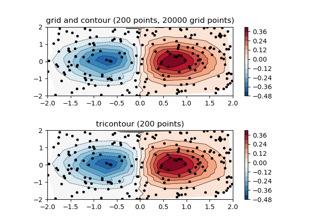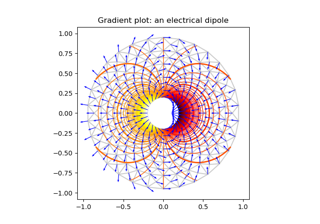matplotlib.axes.Axes.tricontour¶
-
Axes.tricontour(*args, **kwargs)¶ Draw contour lines on an unstructured triangular grid.
The triangulation can be specified in one of two ways; either
tricontour(triangulation, ...)
where triangulation is a
Triangulationobject, ortricontour(x, y, ...) tricontour(x, y, triangles, ...) tricontour(x, y, triangles=triangles, ...) tricontour(x, y, mask=mask, ...) tricontour(x, y, triangles, mask=mask, ...)
in which case a
Triangulationobject will be created. See that class' docstring for an explanation of these cases.The remaining arguments may be:
tricontour(..., Z)
where Z is the array of values to contour, one per point in the triangulation. The level values are chosen automatically.
tricontour(..., Z, levels)
contour up to levels+1 automatically chosen contour levels (levels intervals).
tricontour(..., Z, levels)
draw contour lines at the values specified in sequence levels, which must be in increasing order.
tricontour(Z, **kwargs)
Use keyword arguments to control colors, linewidth, origin, cmap ... see below for more details.
Parameters: - triangulation
Triangulation, optional The unstructured triangular grid.
If specified, then x, y, triangles, and mask are not accepted.
- x, yarray-like, optional
The coordinates of the values in Z.
- trianglesint array-like of shape (ntri, 3), optional
For each triangle, the indices of the three points that make up the triangle, ordered in an anticlockwise manner. If not specified, the Delaunay triangulation is calculated.
- maskbool array-like of shape (ntri), optional
Which triangles are masked out.
- Zarray-like(N, M)
The height values over which the contour is drawn.
- levelsint or array-like, optional
Determines the number and positions of the contour lines / regions.
If an int n, use
MaxNLocator, which tries to automatically choose no more than n+1 "nice" contour levels between vmin and vmax.If array-like, draw contour lines at the specified levels. The values must be in increasing order.
Returns: Other Parameters: - colorscolor string or sequence of colors, optional
The colors of the levels, i.e., the contour lines.
The sequence is cycled for the levels in ascending order. If the sequence is shorter than the number of levels, it's repeated.
As a shortcut, single color strings may be used in place of one-element lists, i.e.
'red'instead of['red']to color all levels with the same color. This shortcut does only work for color strings, not for other ways of specifying colors.By default (value None), the colormap specified by cmap will be used.
- alphafloat, default: 1
The alpha blending value, between 0 (transparent) and 1 (opaque).
- cmapstr or
Colormap, default:rcParams["image.cmap"](default:'viridis') A
Colormapinstance or registered colormap name. The colormap maps the level values to colors.If both colors and cmap are given, an error is raised.
- norm
Normalize, optional If a colormap is used, the
Normalizeinstance scales the level values to the canonical colormap range [0, 1] for mapping to colors. If not given, the default linear scaling is used.- origin{None, 'upper', 'lower', 'image'}, default: None
Determines the orientation and exact position of Z by specifying the position of
Z[0, 0]. This is only relevant, if X, Y are not given.- None:
Z[0, 0]is at X=0, Y=0 in the lower left corner. - 'lower':
Z[0, 0]is at X=0.5, Y=0.5 in the lower left corner. - 'upper':
Z[0, 0]is at X=N+0.5, Y=0.5 in the upper left corner. - 'image': Use the value from
rcParams["image.origin"](default:'upper').
- None:
- extent(x0, x1, y0, y1), optional
If origin is not None, then extent is interpreted as in
imshow: it gives the outer pixel boundaries. In this case, the position of Z[0, 0] is the center of the pixel, not a corner. If origin is None, then (x0, y0) is the position of Z[0, 0], and (x1, y1) is the position of Z[-1, -1].This argument is ignored if X and Y are specified in the call to contour.
- locatorticker.Locator subclass, optional
The locator is used to determine the contour levels if they are not given explicitly via levels. Defaults to
MaxNLocator.- extend{'neither', 'both', 'min', 'max'}, default: 'neither'
Determines the
tricontour-coloring of values that are outside the levels range.If 'neither', values outside the levels range are not colored. If 'min', 'max' or 'both', color the values below, above or below and above the levels range.
Values below
min(levels)and abovemax(levels)are mapped to the under/over values of theColormap. Note that most colormaps do not have dedicated colors for these by default, so that the over and under values are the edge values of the colormap. You may want to set these values explicitly usingColormap.set_underandColormap.set_over.Note
An existing
TriContourSetdoes not get notified if properties of its colormap are changed. Therefore, an explicit call toContourSet.changed()is needed after modifying the colormap. The explicit call can be left out, if a colorbar is assigned to theTriContourSetbecause it internally callsContourSet.changed().- xunits, yunitsregistered units, optional
Override axis units by specifying an instance of a
matplotlib.units.ConversionInterface.- linewidthsfloat or array-like, default:
rcParams["contour.linewidth"](default:None) The line width of the contour lines.
If a number, all levels will be plotted with this linewidth.
If a sequence, the levels in ascending order will be plotted with the linewidths in the order specified.
If None, this falls back to
rcParams["lines.linewidth"](default:1.5).- linestyles{None, 'solid', 'dashed', 'dashdot', 'dotted'}, optional
If linestyles is None, the default is 'solid' unless the lines are monochrome. In that case, negative contours will take their linestyle from
rcParams["contour.negative_linestyle"](default:'dashed') setting.linestyles can also be an iterable of the above strings specifying a set of linestyles to be used. If this iterable is shorter than the number of contour levels it will be repeated as necessary.
- triangulation

